2014 SUBARU TRIBECA seats
[x] Cancel search: seatsPage 32 of 426
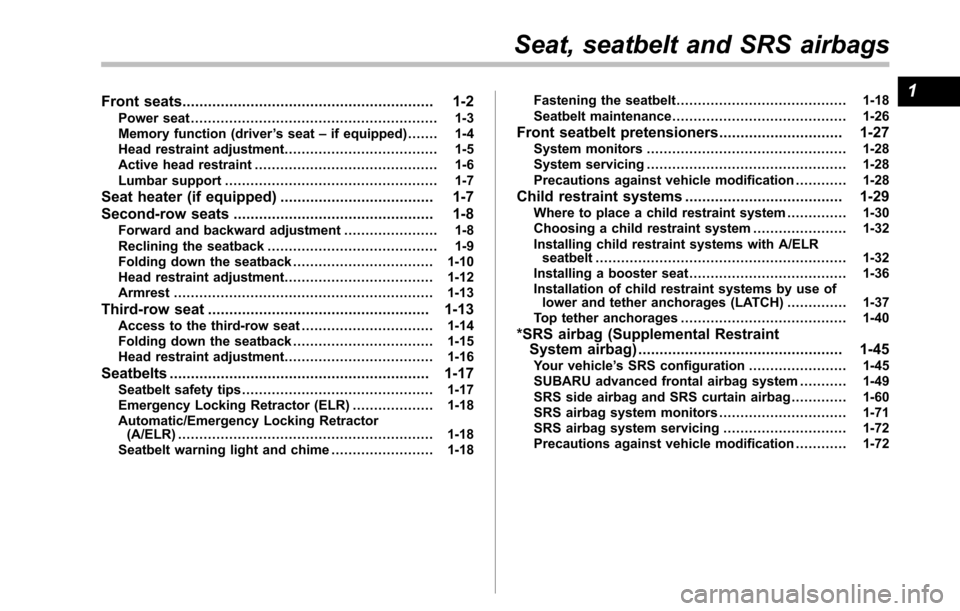
Front seats........................................................... 1-2Power seat.......................................................... 1-3Memory function (driver’s seat–if equipped)....... 1-4Head restraint adjustment.................................... 1-5Active head restraint........................................... 1-6Lumbar support.................................................. 1-7
Seat heater (if equipped).................................... 1-7
Second-row seats............................................... 1-8Forward andbackward adjustment...................... 1-8Reclining the seatback........................................ 1-9Folding down the seatback................................. 1-10Head restraint adjustment................................... 1-12Armrest............................................................. 1-13
Third-row seat.................................................... 1-13Access to the third-row seat............................... 1-14Folding down the seatback................................. 1-15Head restraint adjustment................................... 1-16
Seatbelts............................................................. 1-17Seatbelt safety tips............................................. 1-17Emergency Locking Retractor (ELR)................... 1-18Automatic/Emergency Locking Retractor(A/ELR)............................................................ 1-18Seatbelt warning light and chime........................ 1-18
Fastening the seatbelt........................................ 1-18Seatbelt maintenance......................................... 1-26
Front seatbelt pretensioners............................. 1-27System monitors............................................... 1-28System servicing............................................... 1-28Precautions against vehicle modification............ 1-28
Child restraint systems..................................... 1-29Where to place a child restraint system.............. 1-30Choosing a child restraint system...................... 1-32Installing child restraint systems with A/ELRseatbelt........................................................... 1-32Installing a booster seat..................................... 1-36Installation of child restraint systems by use oflower and tether anchorages (LATCH).............. 1-37Top tether anchorages....................................... 1-40
*SRS airbag (Supplemental RestraintSystem airbag)................................................ 1-45Your vehicle’s SRS configuration....................... 1-45SUBARU advanced frontal airbag system........... 1-49SRS side airbagand SRS curtain airbag............. 1-60SRS airbag system monitors.............................. 1-71SRS airbag system servicing ............................. 1-72Precautions against vehicle modification............ 1-72
Seat, seatbelt and SRS airbags
1
Page 33 of 426

1-2Seat, seatbelt and SRS airbags
Front seats
WARNING
.Never adjust the seat while driv-ing to avoid loss of vehicle con-trol and personal injury.
.Before adjustingthe seat, makesure luggage and the hands andfeet of second-row seat passen-gers are clear of the adjustingmechanism.
.Do not put objects under the frontseats. They may interfere withfront seat locking and cause anaccident.
.Seatbelts provide maximum re-straint when the occupant sitswell back and upright in the seat.To r e d u c e t h e r i s k o f s l i d i n gunder the seatbelt in a collision,the front seatbacks should bealways used in the upright posi-tion while the vehicle is running.If the front seatbacks are notused in the upright position in acollision, the risk of sliding underthe lap belt and of the lap beltsliding up over the abdomen willincrease, and both can result inserious internalinjury or death.
.The SRS airbags deploy withconsiderable speed and force.Occupants who are out of properposition when the SRS airbagdeploys could suffer very seriousinjuries. Because the SRS airbagneeds enough space for deploy-ment, the driver should alwayssit upright and well back in theseat as far from the steeringwheel as practical while stillmaintaining full vehicle controland the frontpassenger shouldmove the seat as far back aspossible and sit upright and wellback in the seat.
WARNING
Put children aged 12 and under in arear seat properly restrained at alltimes. The SRS airbag deploys withconsiderable speed and force andcan injure or even kill children,especially if they are 12 years ofage and under and are not re-strained or improperly restrained.Because children are lighter andweaker than adults, their risk ofbeing injured from deployment isgreater. Consequently, we stronglyrecommend that ALL children (in-cluding those in child seats andthose that have outgrown child re-straint devices) sit in a REAR seatproperly restrained at all times in achild restraint device or in a seat-belt, whichever is appropriate forthe child’s age, height and weight.
Always secure ALL types of childrestraint devices (including forwardfacingchild seats) in one of the rearseating positions recommended inthis Owner’s Manual.
NEVER INSTALL A REARWARD FA-CING CHILD SEAT IN THE FRONTSEAT. DOING SO RISKS SERIOUSINJURY OR DEATH TO THE CHILDBY PLACING THE CHILD’S HEAD
Page 37 of 426
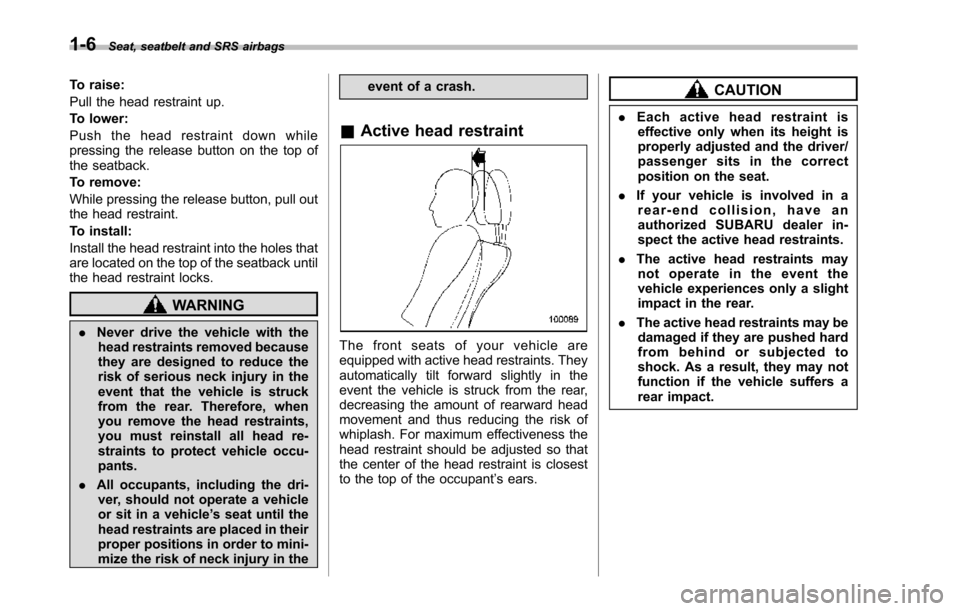
1-6Seat, seatbelt and SRS airbags
To raise:
Pull the head restraint up.
To lower:
Push the head restraint down whilepressing the release button on the top ofthe seatback.
To remove:
While pressing the release button, pull outthe head restraint.
To install:
Install the head restraint into the holes thatare located on the top of the seatback untilthehead restraint locks.
WARNING
.Never drive the vehicle with thehead restraints removed becausethey are designed to reduce therisk of serious neck injury in theevent that the vehicle is struckfrom the rear. Therefore, whenyou remove the head restraints,youmust reinstall all head re-straints to protect vehicle occu-pants.
.All occupants, including the dri-ver, should not operate a vehicleor sit in a vehicle’s seat until thehead restraints are placed in theirproper positions in order to mini-mize the risk of neck injury in the
event of a crash.
&Active head restraint
The front seats of your vehicle areequipped with active head restraints. Theyautomaticallytilt forward slightly in theevent the vehicle is struck from the rear,decreasing the amount of rearward headmovement and thus reducing the risk ofwhiplash. For maximum effectiveness thehead restraintshould be adjusted so thatthe center of the head restraint is closestto the top of the occupant’s ears.
CAUTION
.Each active head restraint iseffective only when its height isproperly adjusted and the driver/passenger sits in the correctposition on the seat.
.If your vehicle is involved in arear-end collision, have anauthorized SUBARU dealer in-spect the active head restraints.
.The active head restraints maynot operate in the event thevehicle experiences only a slightimpact in the rear.
.The activehead restraints may bedamaged if they are pushed hardfrom behind or subjected toshock. As a result, they may notfunction if the vehicle suffers arear impact.
Page 38 of 426
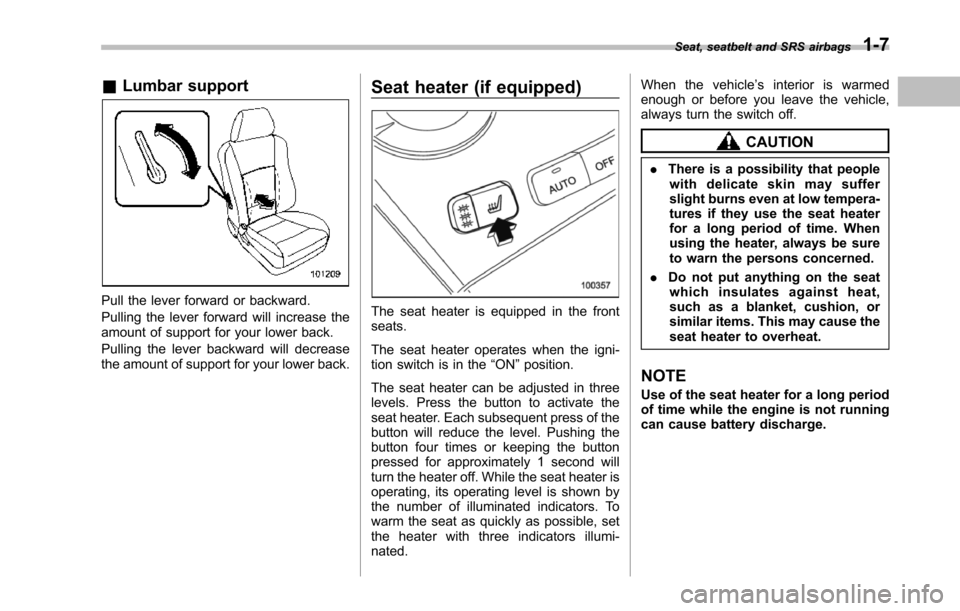
&Lumbar support
Pull the lever forward or backward.
Pulling the lever forward will increase theamountof support for your lower back.
Pulling the lever backward will decreasethe amount of support for your lower back.
Seat heater (if equipped)
Theseat heater is equipped in the frontseats.
Theseat heater operates when the igni-tion switch is in the“ON”position.
The seat heater can be adjusted in threelevels. Press the button to activate theseat heater. Each subsequent press of thebutton will reduce the level. Pushing thebutton four times or keeping the buttonpressed for approximately 1 second willturn the heater off. While the seat heater isoperating, its operating level is shown bythe number of illuminated indicators. Towarm the seat as quickly as possible, setthe heater with three indicators illumi-nated.
When the vehicle’s interior is warmedenough or before you leave the vehicle,always turn the switch off.
CAUTION
.There is a possibility that peoplewith delicate skin may sufferslightburns even at low tempera-tures if they use the seat heaterfor a long period of time. Whenusing the heater, always be sureto warn the persons concerned.
.Do not put anything on the seatwhich insulates against heat,such as a blanket, cushion, orsimilaritems. This may cause theseat heater to overheat.
NOTE
Use of the seat heater for a long periodof time while the engine is not runningcan cause battery discharge.
Seat, seatbelt and SRS airbags1-7
Page 39 of 426
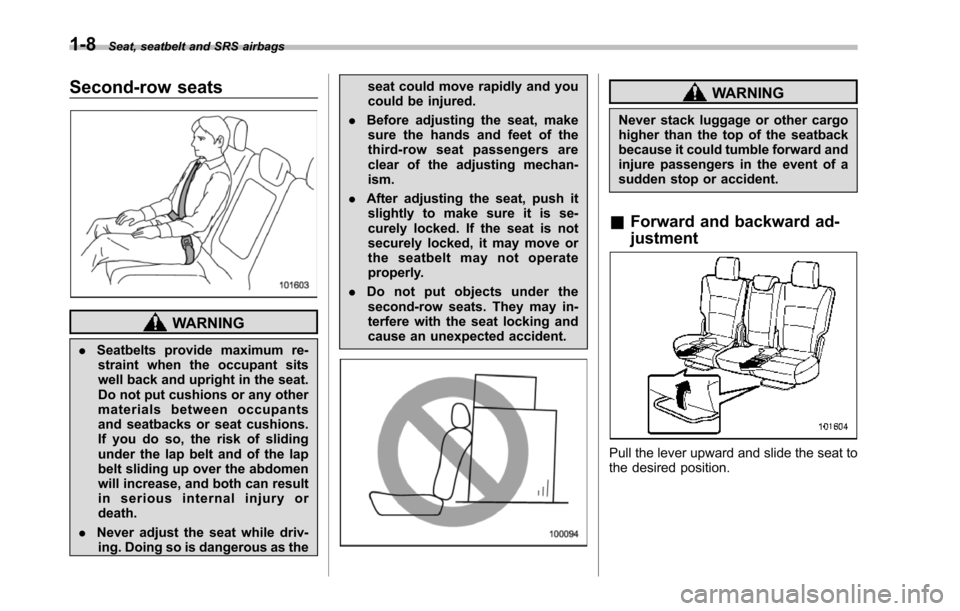
1-8Seat, seatbelt and SRS airbags
Second-row seats
WARNING
.Seatbelts provide maximum re-straint when the occupant sitswell back and upright in the seat.Do not put cushions or any othermaterials between occupantsand seatbacks or seat cushions.If you do so, the risk of slidingunder the lap belt and of the lapbelt sliding up over the abdomenwill increase, and both can resultin serious internal injury ordeath.
.Neveradjust the seat while driv-ing. Doing so is dangerous as the
seat could move rapidly and youcould be injured.
.Before adjusting the seat, makesure the hands and feet of thethird-row seat passengers areclear of the adjusting mechan-ism.
.Afteradjusting the seat, push itslightly to make sure it is se-curely locked. If the seat is notsecurely locked, it may move orthe seatbelt may not operateproperly.
.Do not put objects under thesecond-row seats. They may in-terfere with the seat locking andcause an unexpected accident.
WARNING
Never stack luggage or other cargohigher than the top of the seatbackbecause it could tumble forward andinjure passengers in the event of asudden stop or accident.
&Forward and backward ad-
justment
Pull the lever upward and slide the seat tothe desired position.
Page 43 of 426
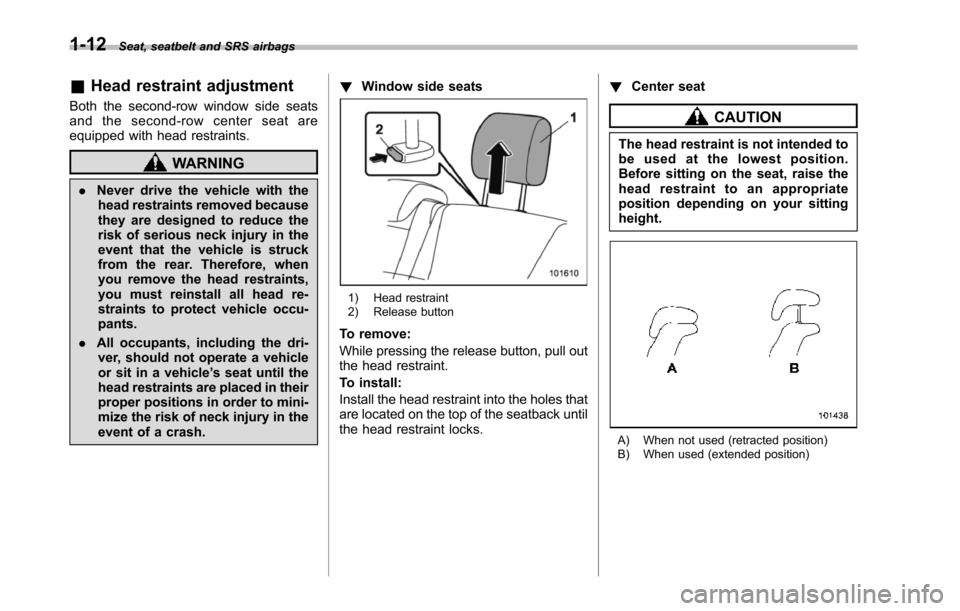
1-12Seat, seatbelt and SRS airbags
&Head restraint adjustment
Both the second-row window side seatsand the second-row center seat areequipped with head restraints.
WARNING
.Never drive the vehicle with thehead restraints removed becausethey are designed to reduce therisk of serious neck injury in theevent that the vehicle is struckfrom the rear. Therefore, whenyou remove the head restraints,you must reinstall all head re-straints to protect vehicle occu-pants.
.All occupants, including the dri-ver, should not operate a vehicleor sit in a vehicle’s seat until thehead restraintsare placed in theirproper positions in order to mini-mize the risk of neck injury in theevent of a crash.
!Window side seats
1) Head restraint2) Release button
To remove:
While pressing the release button, pull outthe head restraint.
To install:
Install the head restraint into the holes thatare located on the top of the seatback untilthe head restraint locks.
!Center seat
CAUTION
The head restraint is not intended tobe used at the lowest position.Before sitting on the seat, raise thehead restraint to an appropriateposition depending on your sittingheight.
A) When not used (retracted position)B) When used (extended position)
Page 47 of 426
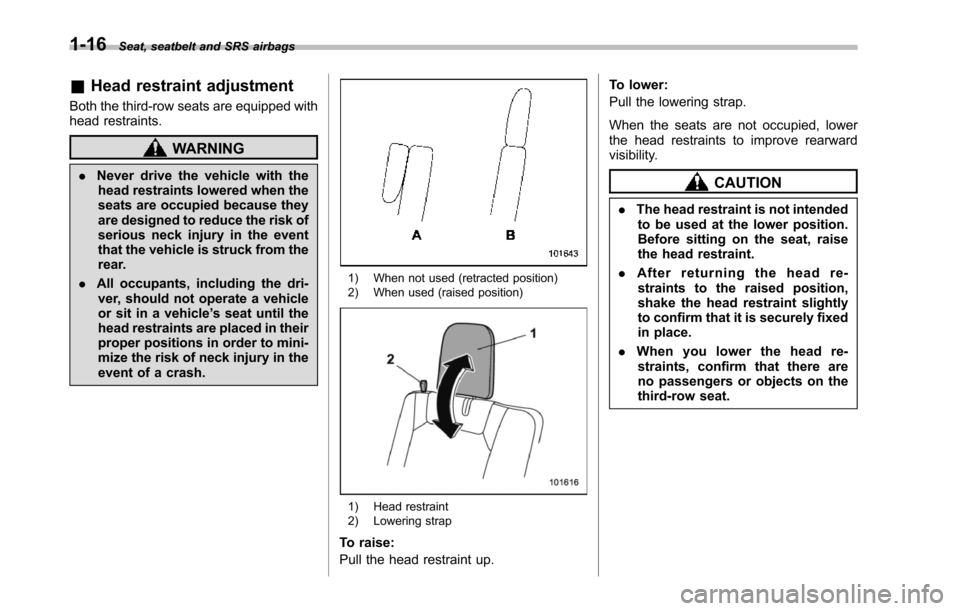
1-16Seat, seatbelt and SRS airbags
&Head restraint adjustment
Both the third-row seats are equipped withhead restraints.
WARNING
.Never drive the vehicle with thehead restraints lowered when theseats are occupied because theyare designed to reduce the risk ofserious neck injury in the eventthat the vehicle is struck from therear.
.All occupants, including the dri-ver, should not operate a vehicleor sit in a vehicle’s seat until thehead restraints are placed in theirproper positions in order to mini-mize the risk of neck injury in theevent of a crash.
1) When not used (retracted position)2) When used (raised position)
1) Head restraint2) Lowering strap
To raise:
Pull the headrestraint up.
To lower:
Pull the lowering strap.
When the seats are not occupied, lowerthe head restraints to improve rearwardvisibility.
CAUTION
.The head restraint is not intendedto be used at the lower position.Before sitting on the seat, raisethe head restraint.
.After returning the head re-straints to the raised position,shake the head restraint slightlyto confirm that it is securely fixedin place.
.When you lower the head re-straints, confirm that there areno passengers or objects on thethird-row seat.
Page 48 of 426
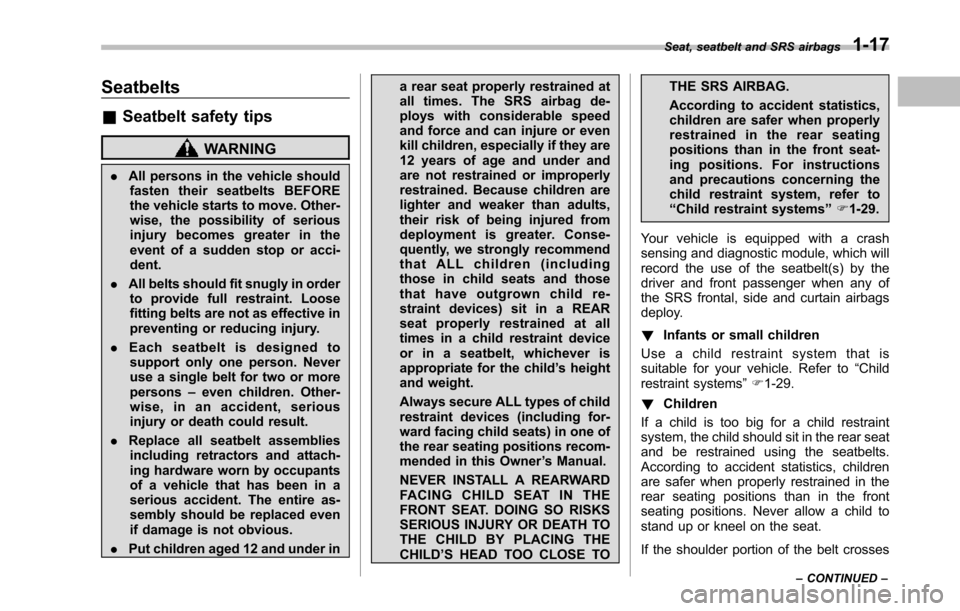
Seatbelts
&Seatbelt safety tips
WARNING
.All persons in the vehicle shouldfasten their seatbelts BEFOREthe vehicle starts to move. Other-wise, the possibility of seriousinjury becomes greater in theevent of a sudden stop or acci-dent.
.All belts should fit snugly in orderto provide full restraint. Loosefitting belts are not as effective inpreventing or reducing injury.
.Each seatbelt is designed tosupport only one person. Neveruse a single belt for two or morepersons–even children.Other-wise, in an accident, seriousinjury or death could result.
.Replace all seatbelt assembliesincluding retractors and attach-ing hardware worn by occupantsof a vehicle that has been in aserious accident. The entire as-sembly should be replaced evenif damage is not obvious.
.Put children aged 12 and under in
a rear seat properly restrained atall times. The SRS airbag de-ploys with considerable speedand force and can injure or evenkill children, especially if they are12 years of age and under andare not restrained or improperlyrestrained. Because children arelighter and weaker than adults,their risk of being injured fromdeployment is greater. Conse-quently, we strongly recommendthat ALL children (includingthose in child seats and thosethat have outgrown child re-straint devices) sit in a REARseat properly restrained at alltimes in a child restraint deviceor in a seatbelt, whichever isappropriate for the child’s heightand weight.
Always secure ALL types of childrestraint devices (including for-ward facing child seats) in one ofthe rear seating positions recom-mended in this Owner’s Manual.
NEVERINSTALL A REARWARDFA C I N G C H I L D S E AT I N T H EFRONT SEAT. DOING SO RISKSSERIOUS INJURY OR DEATH TOTHE CHILD BY PLACING THECHILD’S HEAD TOO CLOSE TO
THE SRS AIRBAG.
According to accident statistics,children are safer when properlyrestrained in the rear seatingpositions than in the front seat-ing positions. For instructionsand precautions concerning thechild restraint system, refer to“Child restraint systems”F1-29.
Your vehicle is equipped with a crashsensing and diagnostic module, which willrecord the use of the seatbelt(s) by thedriver and front passenger when any ofthe SRS frontal, side and curtain airbagsdeploy.
!Infants or small children
Use a child restraint system that issuitable for your vehicle. Refer to“Childrestraint systems”F1-29.
!Children
If a child is too big for a child restraintsystem, the child should sit in the rear seatand be restrained using the seatbelts.According to accident statistics, childrenare safer when properly restrained in therear seating positions than in the frontseating positions.Never allow a child tostand up or kneel on the seat.
If the shoulder portion of the belt crosses
Seat, seatbelt and SRS airbags1-17
–CONTINUED–